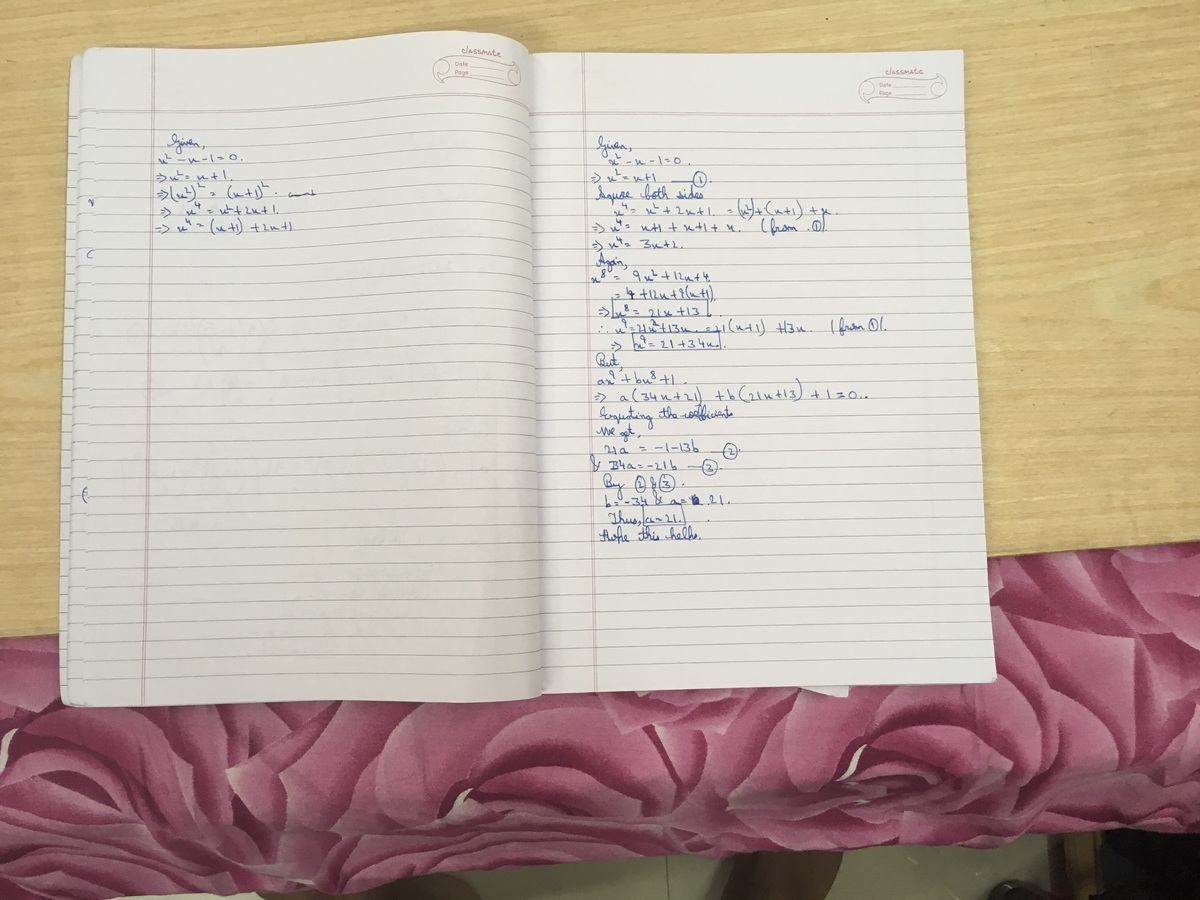#20 of June 2016 Grade 10 CSAT (Korean SAT) mock test
a x 9 + b x 8 + 1 is divisible by x 2 − x − 1 , where two polynomials are both functions of x .
Find the value of a .
This problem is a part of <Grade 10 CSAT Mock test> series .
The answer is 21.
This section requires Javascript.
You are seeing this because something didn't load right. We suggest you, (a) try
refreshing the page, (b) enabling javascript if it is disabled on your browser and,
finally, (c)
loading the
non-javascript version of this page
. We're sorry about the hassle.
4 solutions
When x 2 − x − 1 = 0 , ⇒ x 2 = x + 1 x 4 = ( x + 1 ) 2 = x 2 + 2 x + 1 = ( x + 1 ) + 2 x + 1 = 3 x + 2 x 8 = ( 3 x + 2 ) 2 = 9 x 2 + 1 2 x + 4 = 9 ( x + 1 ) + 1 2 x + 4 = 2 1 x + 1 3 x 9 = x ( 2 1 x + 1 3 ) = 2 1 x 2 + 1 3 = 2 1 ( x + 1 ) + 1 3 = 3 4 x + 2 1
Since a x 9 + b x 8 + 1 is divisible by x 2 − x − 1 , we deduce that these two polynomials have common roots.
Hence, by substitution
a x 9 + b x 8 + 1 = 0 can be rewritten as a ( 3 4 x + 2 1 ) + b ( 2 1 x + 1 3 ) + 1 = 0 Equating the coefficients of each term, we get { 3 4 a + 2 1 b = 0 2 1 a + 1 3 b + 1 = 0
Solving the system of simultaneous equations, we get a = 2 1 , b = − 3 4 .
Just use polynomial division. And equate the remainder to zero,because it completely divides. You get 2 simultaneous linear equations. Solve them to get A.

Let p , q be roots of x 2 − x − 1 = 0 . Then, p + q = 1 and p q = − 1 .
Therefore, p 2 + q 2 = 3 and p 4 + q 4 = 7 .
Since a x 9 + b x 8 + 1 = ( x 2 − x − 1 ) Q ( x ) ,
a p 9 + b p 8 = − 1 ⋯ A a q 9 + b q 8 = − 1 ⋯ B
Multiply q 8 to both sides of A , and p 8 to both sides of B .
a p ( p q ) 8 + b ( p q ) 8 = − q 8 a q ( p q ) 8 + b ( p q ) 8 = − p 8
Since p q = − 1 ,
a p + b = − q 8 a q + b = − p 8
Subtract the lower equation from the upper equation and you get
a ( p − q ) a = p 8 − q 8 = p − q p 8 − q 8 = ( p − q ) ( p 4 + q 4 ) ( p 2 + q 2 ) ( p + q ) ( p − q ) = 7 × 3 × 1 = 2 1